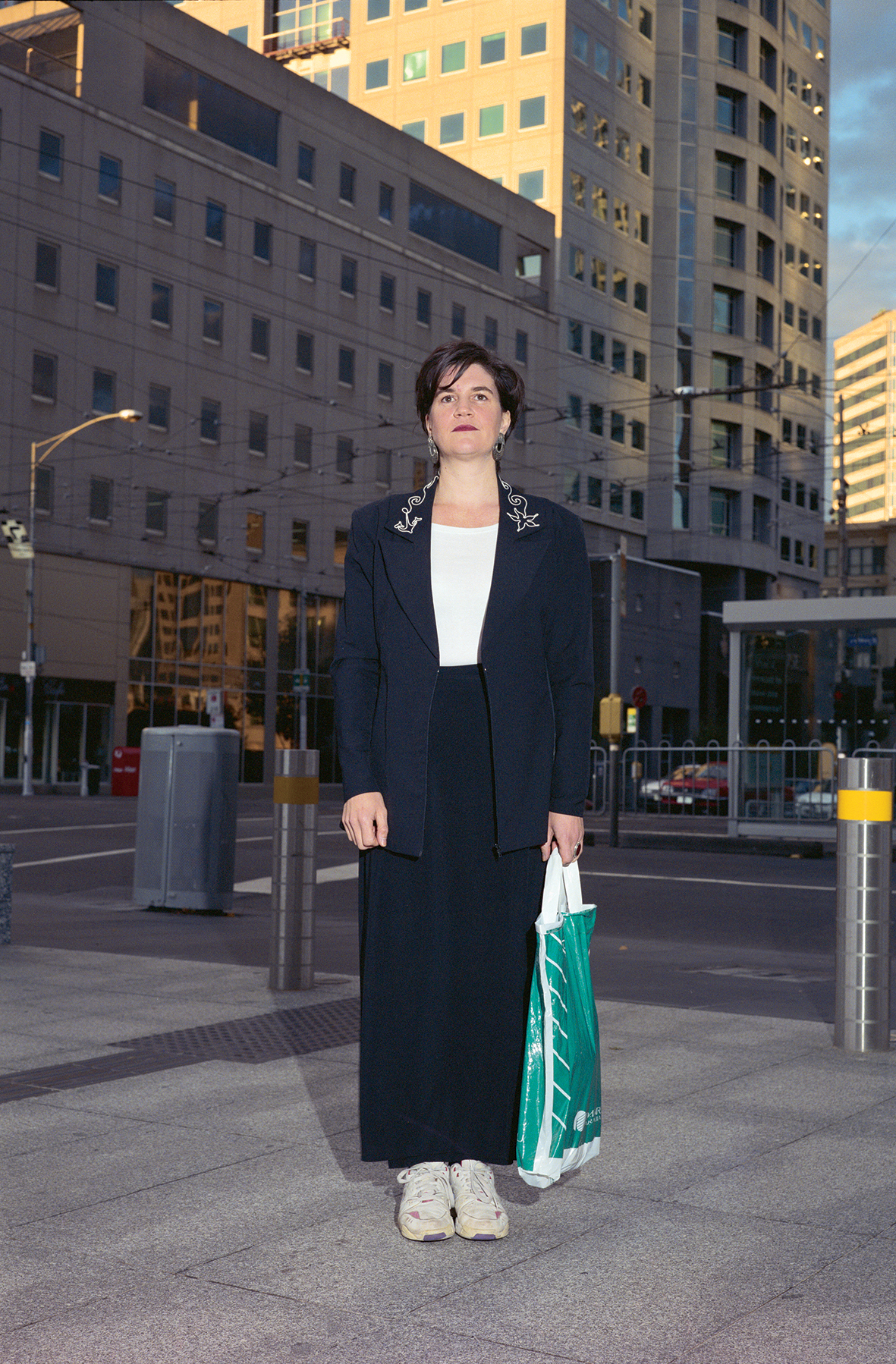





Citylights Projects
Review by Samantha Semmens
LIKE Art Magazine, Spring 2001
The transitory, fugitive element whose metamorphoses are so rapid must on no account be despised... (Charles Baudelaire)
It's a little bit cold, a little bit harsh, but this scrutiny of the subject has to do with not evading the facts, not evading what it really looks like. (Diane Arbus)
Unlike Walker Evans' 'Female Pedestrian, New York', Sanja Pahoki's subjects are not shot in mid‑step. Instead of capturing the 'fugitive element' in action ‑ the hurried stride of the city worker ‑ Pahoki has slowed the pace. She has beckoned commuters from the rush hour flow, used flash lighting to create the illusion of perfect stillness, and then suspended the images on light boxes in the becalmed space of a cul‑de‑sac, off an arcade, off a lane. Yet her camera's slow scrutiny has not produced a pacified image of women, but has recorded something at work in their bodies (or in their bodies at work) that is between the transitory and the fixed.
The four photographs make visible the codes of movement and inhibition already inscribed on the bodies of women as they alight each day from their trains, make for the towers behind them and scale corporate heights with varying degrees of success. At first these women look poised to make it; primed for the ascent in runners that denote not only movement, but stamina, endurance and prowess.
The photographs seductively portray these women as being in harmony with their surroundings. There is a kind of shared morphology between the ‘body' of the city ‑ the clutch of corporate towers ‑ and the bodies of the women. The standing figures, with their erect torsos, straight limbs and sturdy shoes buttress the tower's denotation as "'stature", "status", "stability", "establishment" and "estate” [which] all share the root sta (to stand)'.1
Colour saturates the images with a palette that blends skin into stone and cloth into concrete and glass. A woman dressed in polished slate‑grey stands on shaded concrete overlooked by shiny, darkened windows. Another, in her buff coloured coat, stands before the equally buff‑coloured Collins Place Tower, which rises up behind her in a seeming extension of her body. Here, the city takes on a softness with warm, skin‑like facades. The light has a liquid quality that washes over the images and pools onto the women's faces where the flash has caught, accentuating the continuity between figures and cityscape.
Yet there is something uncanny about all of this apparent harmony. The city looks eerily silent and uncommonly pristine. While the staging of the shots did not impinge on the surrounding choreography of the street, Pahoki's camera has recorded something resembling a film set onto which the extras ‑ the mass of workers ‑ have not yet been called, like the frozen streetscape in The Truman Show seconds before the 'rush hour’ cue. The buildings themselves, their soaring lines so sharply delineated, appear hyperreal; more like an abstract principle of perfection than something that will actually arm corporate lessees with the solidity, security and permanence supposedly ascribed to stone.
The women in their hybrid attire also embody a corporate identity that does not cohere. If getting the dress code right is symbolic of worldly success, these women are instead flouting the corporate code that privileges the rational, controlled (and notably male) body. They are not even trying, as a dearth of discreet black sneakers or sensible leather lace-ups attests! But rather than refusing to 'play the game', they reveal their position within it. What makes their attire 'suitable' is that it allows for a tension between being 'corporate' and being a woman. It is notable that corporate women are expected to embody both masculinity and femininity in their dress and behaviour at work, being, for instance, both a 'softening influence' and a savvy key player.
Negotiating these boundaries can be confusing, as a comment made by a female financier in London suggests: 'l wear these men's shirts, I mean they are ladies', they are made for ladies at a men's tailors'.2
Likewise, the runners both avow and disavow femininity, replacing yet also alluding to the feminine heels concealed in carry bags.
The cul‑de‑sac off Centre Place where the images are exhibited is, like the images themselves, contradictory. It is a feminine space ‑ enclosing ‑ yet of itself neither closed nor open. It is neither outside nor inside, insofar as it is walled yet open to the sky. In other ways, too, this little appendix is liminal ‑ neither for work nor for leisure, and at once abject and edifying, with both rubbish bins and art lining its walls.
The installed light-boxes boldly lay claim to the cul‑de‑sac, without colonising it as private gallery space. Thus it is left open for artists and the passing public to interpret the contradictions and unlikely meetings it engenders. The women Pahoki has photographed may still only be lightly imprinted on the corporate world, grappling with the contradictions it poses, yet their bodies resist a purely feminised inscription. Likewise, their brightly‑lit images are not absorbed by the space of the cul‑de‑sac, but leap from its walls.
Footnotes
1. Kim Dovey, Framing Places: Mediating Power in Built Form, (London: Routledge, 1999), p. 109.
2. Linda McDowell, Capital Culture:Gender at Work in the City, (Oxford Blackwell, 1997), p. 146.